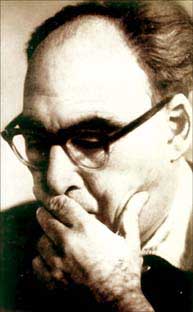.
Alfréd Rényi

Alfréd Rényi (March 20, 1921 – February 1, 1970) was a Hungarian mathematician who made contributions in combinatorics and graph theory but mostly in probability theory.[1][2]
Rényi was born in Budapest to Artur Rényi and Barbara Alexander; his father was a mechanical engineer while his mother was the daughter of a philosopher and lterary critic, Bernát Alexander. He was prevented from enrolling in university in 1939 due to the anti-Jewish laws then in force, but enrolled at the University of Budapest in 1940 and finished his studies in 1944. At this point he was imprisoned in a labor camp, escaped, and completed his Ph.D. in 1947 at the University of Szeged, under the advisement of Frigyes Riesz.[3] He married Katalin Schulhof, herself a mathematician, in 1946; his daughter Zsuzsa was born in 1948. After a brief assistant professorship at Budapest, he was appointed Professor Extraordinary at the University of Debrecen in 1949.
He proved, using the large sieve, that there is a number K such that every even number is the sum of a prime number and a number that can be written as the product of at most K primes. See also Goldbach conjecture.
In information theory, he introduced the spectrum of Rényi entropies of order α, giving an important generalisation of the Shannon entropy and the Kullback-Leibler divergence. The Rényi entropies give a spectrum of useful diversity indices, and lead to a spectrum of fractal dimensions.
He founded the Mathematical Institute in Budapest, now called The Alfréd Rényi Institute of Mathematics. There are currently approximately 70 mathematicians doing research at the Institute.
He wrote 32 joint papers with Paul Erdős,[4] the most well-known of which are his papers introducing the Erdős–Rényi model of random graphs.[5] Alfréd Rényi is probably the source of the quote: "A mathematician is a device for turning coffee into theorems.", which is generally ascribed to Erdős.
He is also famous for having said, "If I feel unhappy, I do mathematics to become happy. If I am happy, I do mathematics to keep happy."[6]
References
1. ^ Kendall, David (1970), "Obituary: Alfred Renyi", Journal of Applied Probability 7 (2): 508–522, <http://links.jstor.org/sici?sici=0021-9002(197008)7%3A2%3C508%3AOAR%3E2.0.CO%3B2-Y>.
2. ^ Revesz, P. & Vincze, I. (1972), "Alfred Renyi, 1921-1970", The Annals of Mathematical Statistics 43 (6): i–xvi, <http://links.jstor.org/sici?sici=0003-4851(197212)43%3A6%3C%3AAR1%3E2.0.CO%3B2-1>.
3. ^ Alfréd Rényi at the Mathematics Genealogy Project
4. ^ http://www.oakland.edu/enp/erdtrib.pdf.
5. ^ "On random graphs", Publ. Math. Debrecen, 1959, and "On the evolution of random graphs", Publ. Math. Inst. Hung. Acad. Sci, 1960.
6. ^ Quoted in Pál Turán, "The Work of Alfréd Rényi", Matematikai Lapok 21 (1970) 199 - 210.
Links
* The life of Alfréd Rényi, by Pál Turán
* O'Connor, John J; Edmund F. Robertson "Alfréd Rényi". MacTutor History of Mathematics archive.
Retrieved from "http://en.wikipedia.org/"
All text is available under the terms of the GNU Free Documentation License


